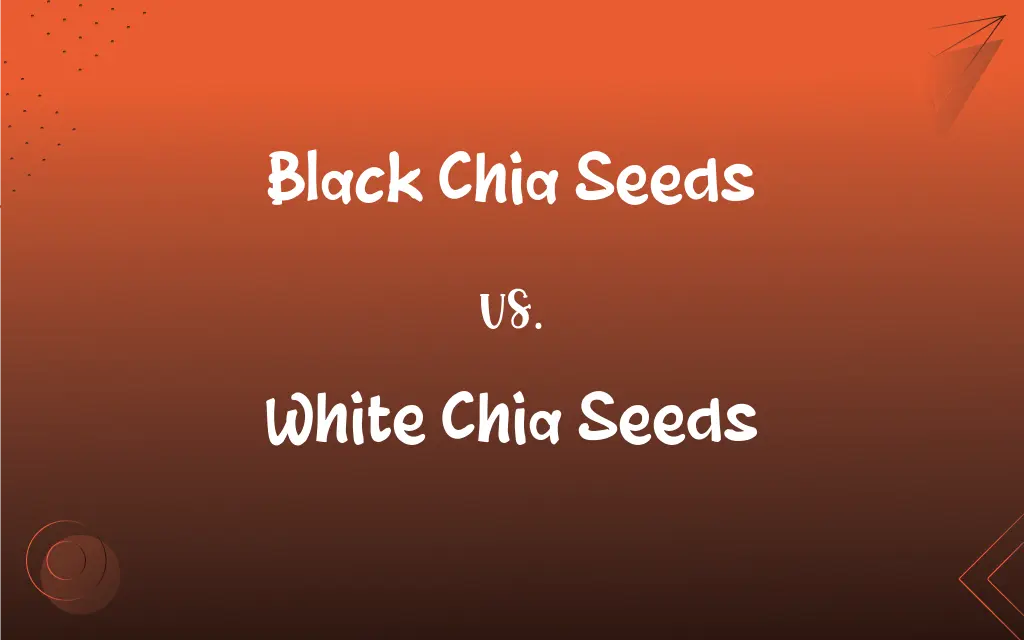Black Chia Seeds vs. White Chia Seeds: What's the Difference?
Edited by Janet White || By Harlon Moss || Updated on July 5, 2024
Black chia seeds are dark-colored varieties; white chia seeds are lighter, but both are nutritionally similar.

Key Differences
Black chia seeds are a variety of chia seeds that have a dark hue, often ranging from black to dark brown. These seeds have become a popular superfood due to their rich nutrient profile. White chia seeds, in contrast, have a lighter, off-white color and are sometimes mistaken for sesame seeds at first glance. Both types hail from the same plant, Salvia hispanica, and are mostly grown in regions like Mexico and South America.
The nutritional profiles of black chia seeds and white chia seeds are remarkably similar. Both are rich in omega-3 fatty acids, fiber, protein, and various minerals and vitamins. The minor differences that might arise in nutrient content are usually due to soil and environmental factors rather than the seed's color.
In terms of culinary uses, both black chia seeds and white chia seeds are versatile. They can be sprinkled on salads, added to smoothies, or used as a thickener in recipes. The choice between black and white often comes down to aesthetic preferences, as the lighter white chia seeds might blend more seamlessly into certain dishes, while the darker black chia seeds can provide a contrasting visual element.
When it comes to taste, there's no significant difference between black chia seeds and white chia seeds. Both varieties have a mild, nutty flavor that doesn't overpower dishes. However, some consumers claim subtle taste nuances between them, often influenced by personal preferences and the specific growing conditions of the seeds.
Comparison Chart
Color
Dark, ranging from black to dark brown
Lighter, often off-white in color
ADVERTISEMENT
Common Culinary Use
Used for visual contrast in dishes
Blends more seamlessly in dishes due to its lighter color
Taste
Mild, nutty flavor, with subtle variations depending on growing conditions
Mild, nutty flavor, with potential slight nuances differing from black chia seeds
Origin
Derived from the plant Salvia hispanica
Derived from the same plant, Salvia hispanica
Nutritional Differences
Nutritionally similar to white chia seeds, with minor variations based on soil and environment
Nearly identical nutritional profile to black chia seeds, any differences are largely due to environmental factors
Black Chia Seeds and White Chia Seeds Definitions
Black Chia Seeds
Dark-hued edible seeds of the Salvia hispanica plant.
The yogurt was topped with a sprinkle of black chia seeds for added crunch.
ADVERTISEMENT
White Chia Seeds
A provider of essential fatty acids, minerals, and vitamins.
White chia seeds added a nutritious punch to her daily shake.
Black Chia Seeds
A superfood known for its rich omega-3 content.
She blended black chia seeds into her morning smoothie for a nutritional boost.
White Chia Seeds
A nutrient-dense superfood similar to its darker counterpart.
He chose white chia seeds for his oatmeal to keep the color consistent.
Black Chia Seeds
Small, dark granules that absorb water and expand.
When soaked, black chia seeds form a gel-like consistency.
White Chia Seeds
Light-colored edible seeds from the Salvia hispanica plant.
The bread was dotted with white chia seeds, giving it a unique texture.
Black Chia Seeds
A source of fiber, protein, and various essential minerals.
For a balanced diet, she incorporated black chia seeds into her meals.
White Chia Seeds
Often used in culinary dishes for their mild flavor.
The salad dressing was thickened using white chia seeds without altering its color.
Black Chia Seeds
Seeds often used as a thickener in recipes.
The pudding's thick consistency was achieved using black chia seeds.
White Chia Seeds
Seeds that can absorb liquids and become gelatinous.
She made a dessert using white chia seeds soaked in almond milk.
FAQs
Can black chia seeds and white chia seeds be used interchangeably?
Yes, they can be used interchangeably in recipes.
Is there a nutritional advantage to using black chia seeds over white chia seeds?
Both black chia seeds and white chia seeds have a similar nutritional profile, so neither has a significant advantage over the other.
Is there a difference in shelf life between black chia seeds and white chia seeds?
No, both types have a similar shelf life when stored properly.
How should both black chia seeds and white chia seeds be stored?
Both should be stored in a cool, dry place, preferably in airtight containers.
Do both black chia seeds and white chia seeds have the same soaking time?
Yes, both types absorb water and expand in a similar timeframe.
Are white chia seeds more expensive than black chia seeds?
Prices can vary based on region and brand, but generally, there's no significant price difference between black chia seeds and white chia seeds.
Do black chia seeds and white chia seeds come from different plants?
No, both come from the same plant, Salvia hispanica.
Are there dishes where white chia seeds are preferred over black chia seeds?
White chia seeds might be preferred in dishes where a lighter color is desired, but it's often a matter of aesthetic choice.
Are the health benefits the same for both black chia seeds and white chia seeds?
Yes, both types offer similar health benefits.
Which type of chia seed has a stronger flavor: black or white?
Both black chia seeds and white chia seeds have a mild, nutty flavor, with no significant difference in taste.
How can I differentiate between black chia seeds and white chia seeds at a glance?
Black chia seeds have a dark hue, while white chia seeds are lighter, often off-white.
Do black chia seeds and white chia seeds need to be ground before consumption?
No, both can be consumed whole, but some people choose to grind them for certain recipes.
Are there any known allergies associated with black chia seeds or white chia seeds?
Some people may be allergic to chia seeds, but it's relatively rare. Always consult with a healthcare professional if concerned.
Can I grow both black chia seeds and white chia seeds at home?
Yes, if you have the right climate and conditions, you can grow both black chia seeds and white chia seeds.
Can black chia seeds and white chia seeds be used as an egg substitute in recipes?
Yes, when soaked and gelled, both types can act as a binding agent, similar to eggs, in some recipes.
Are there any cuisines that specifically use black chia seeds over white chia seeds, or vice versa?
Both black chia seeds and white chia seeds are versatile and can be used in various cuisines. The choice often depends on aesthetic preferences.
Can black chia seeds change the color of my dish?
Black chia seeds might impart a darker hue to very light-colored dishes.
Can both black chia seeds and white chia seeds be used in baking?
Absolutely, both can be incorporated into baked goods.
Do black chia seeds and white chia seeds have different textures?
Both have a similar texture, but when soaked, they form a gel-like consistency.
How do I know if my black chia seeds or white chia seeds have gone bad?
If they develop an off or rancid smell, it's best to discard them.
About Author
Written by
Harlon MossHarlon is a seasoned quality moderator and accomplished content writer for Difference Wiki. An alumnus of the prestigious University of California, he earned his degree in Computer Science. Leveraging his academic background, Harlon brings a meticulous and informed perspective to his work, ensuring content accuracy and excellence.
Edited by
Janet WhiteJanet White has been an esteemed writer and blogger for Difference Wiki. Holding a Master's degree in Science and Medical Journalism from the prestigious Boston University, she has consistently demonstrated her expertise and passion for her field. When she's not immersed in her work, Janet relishes her time exercising, delving into a good book, and cherishing moments with friends and family.































































